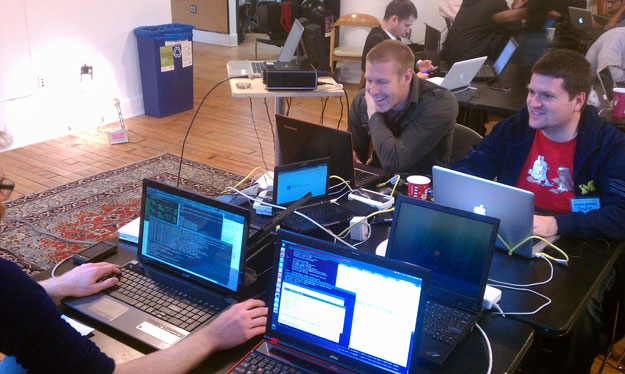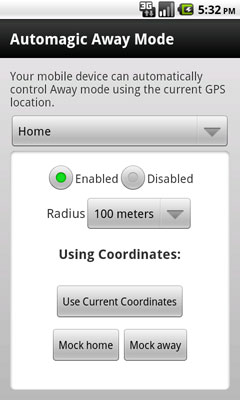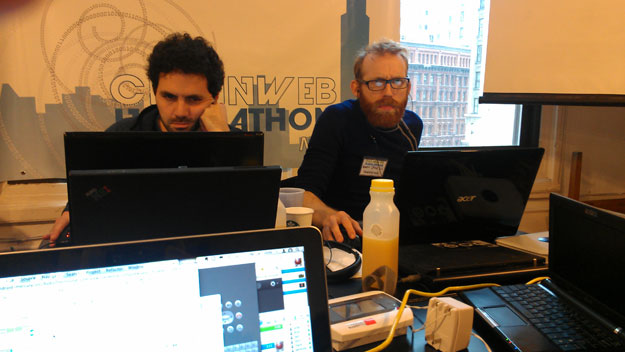
EnergyHub Team
February 3, 2012
Last weekend, EnergyHub sent a team of crack developers (and me) to participate in New York city’s first Cleanweb Hackathon. The event, sponsored by NYSERDA and a host of private companies, aimed to promote innovation and cooperation in information technology with a focus on promoting energy efficiency and clean energy. There was a lot of focus on datasets: records of energy used by buildings, the solar potential of rooftops in the area, and even the schedules of the MTA’s trains and buses.
The idea behind the hackathon is that if you put enough software geniuses (you know, the ones who learned to program before they could walk) into a room full of data, Mountain Dew, and pizza and shut the door, when you come back the next day, you will find that their unintelligible piles of numbers have synthesized into compelling graphs, informative web sites, and even new business ideas.

Hubbers Mark Whitney and Brad Zawacki at the Cleanweb Hackathon last weekend in NYC.
Some of this may be true. But allow me a minute to explain what a hackathon really is. I think the image that pops into many people’s heads comes from The Social Network – a bunch of geeks clustered around a ring of computers in a dark room, writing programs to break into government computers, taking shots of whiskey and cheering. This hackathon was not quite as intense – there was little or no cybercrime – but it did last two, round-the-clock, days. There were an awful lot of laptops, plenty of pizza, and definitely a few geeks, but most of the attendees were surprisingly well adjusted socially, and most were equally likely to geek out about the latest government program for improving energy efficiency as they were to argue over the advantages of node.js, jRuby, cPython or asp.net. There were also a few good designers and business folk participating. They brought valuable perspectives and design capabilities into a world dominated by programmers who would be perfectly happy if Facebook had nothing but a text-mode command-line interface.
The instructions were pretty simple: the datasets were posted before the event, and people who had an idea of what to create stood up at the beginning and explained their idea. One person wanted to make a web site to help people find more efficient ways to commute – carpools, buses, or biking. Another wanted to use public data to show how the 1% had higher carbon footprints than the rest of us. Somebody else pitched a project that would quickly assess whether a building was a good candidate for energy efficiency improvements. Participants were invited to join whichever team looked most interesting. At the end of the hackathon, judges would choose their favorites and hand out prizes, including cash and a digital camera.
EnergyHub’s team came to the event with this perspective: we knew most of the teams would be exercising the datasets that had been posted, but we figured that the special sauce we could bring to the party was device control. EnergyHub’s “thing” is energy efficiency and demand response in the connected home – we make web and mobile software for smart thermostats and build a home energy management system that helps people get a handle on their energy use, all with powerful yet simple interfaces that a grandma could use.
For our hack, we mulled over a bunch of ideas and arrived at the one that we felt had the greatest potential to save energy and extract the most benefit from a smart thermostat. Effectively, the hack added location awareness to our Android phone thermostat control app. We set it up so that you (the user) can tell our servers where your home is, and when you go a specified distance away from that location, the app on your phone notifies our server. When the last smartphone that belongs to your account leaves that specified home area, the thermostat automatically switches into away mode, setting back the temperature (up or down, in summer and winter, respectively) and saving energy.

Automagic senses your location and puts your home
automatically into Away mode when you leave.
What’s particularly cool (pun intended) about this tool is that it enables a meaningful improvement in energy efficiency using the devices that a smart thermostat owner almost certainly already has and it does it without requiring the user to do or buy anything special. You could also do this with occupancy sensors, but those cost money and require installation and maintenance. All our solution needs is a smartphone, which a tech savvy user is practically guaranteed to have anyway, and a connected thermostat.
And the takeaway? Well, we didn’t win. That’s fine – we figured that the winner would be doing something with public datasets, which was basically true, but I think it is telling that the team that won the most accolades, Econofy, actually had to scrape much of the data from pdfs because they were not available in any computer-friendly format. But we were pretty happy to make a cool piece of software, and it was also great to meet the other participants and judges.
Among the judges were two government officials who have the power to make the public data better, more useful, and more available. They were Aneesh Chopra, the first CTO of the United States and Rachel Sterne, the first to hold the new Chief Digital Officer position for the City of New York (unfortunately for the tech community in America, Mr. Chopra resigned from his position a week later). It’s encouraging to see the government giving some much-needed attention to technology. And this brings me to what I hope will be the biggest net benefit coming out of this event. During the event, both Mr. Chopra and Ms. Sterne seemed to be most interested in the way that the public data failed the developers during the event.
One team from building efficiency auditors BrightPower found themselves unable to make use of the public power database because the building classification data did not give enough detail to assess whether a building was performing badly. Similarly, the Econofy team helped to highlight a shortcoming in the ENERGY STAR requirements: although appliance makers must submit information on the efficiency of the devices they produce, that information is not accessible via software.

Focus, focus, focus. Me (Dan Riegel) and Andy O’Neill, with our team’s 7 computers, making stuff work.
Making this data more accessible and comprehensive would be a simple change, but one that is essential for fostering technology innovation. Equipped with more usable data, clever hackers and designers could get down to crafting better consumer-focused tools. And these are the tools, inspired by events like this hackathon, that will help consumers see the tradeoffs they are making when they choose to buy, say, an energy-hogging plasma TV instead of an LCD TV.
Mr. Chopra made a brief speech at the end. He talked about the Green Button initiative, a recently released standard that allows people to download their energy use data from utilities in a consistent format. Standards like this should allow people around the country with different utilities and different meters to use the same software to understand and improve their energy efficiency. As more and more information gets staged online, we can expect to see a sharp uptick in web sites doing interesting things with the data, and the single biggest thing that the government can do to facilitate this is to remove roadblocks and friction. This way, a developer can save the time it might take to scrape data from an unfriendly web site, and instead jump straight to the interesting part: mashing up energy use, solar potential, appliances, location data, work schedule, etc., to advance the cleanweb revolution, bit by bit.
Posted by Dan Riegel, Software Director
Interested in keeping up with the latest dispatch from the grid edge?
Get our next post in your inbox.


